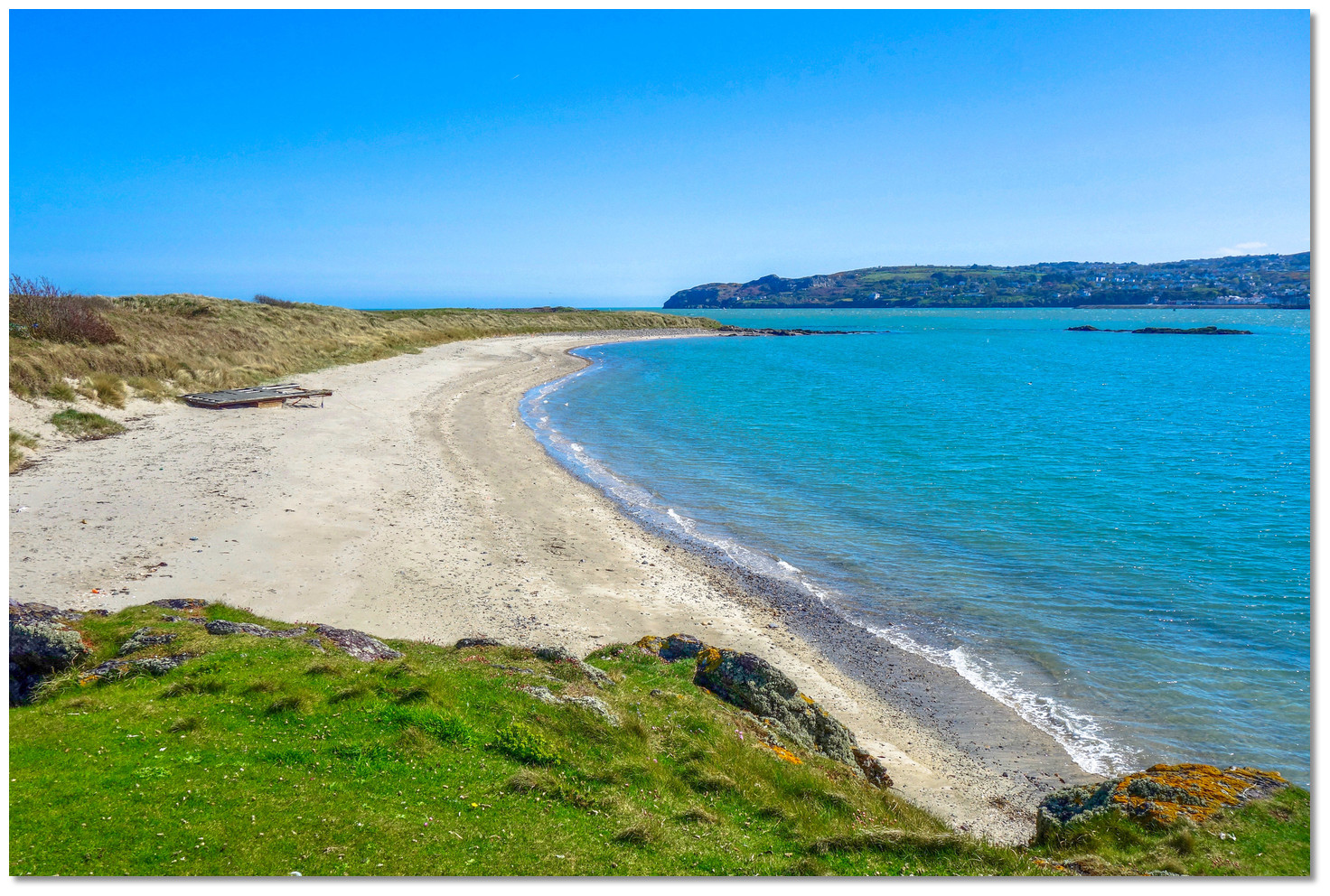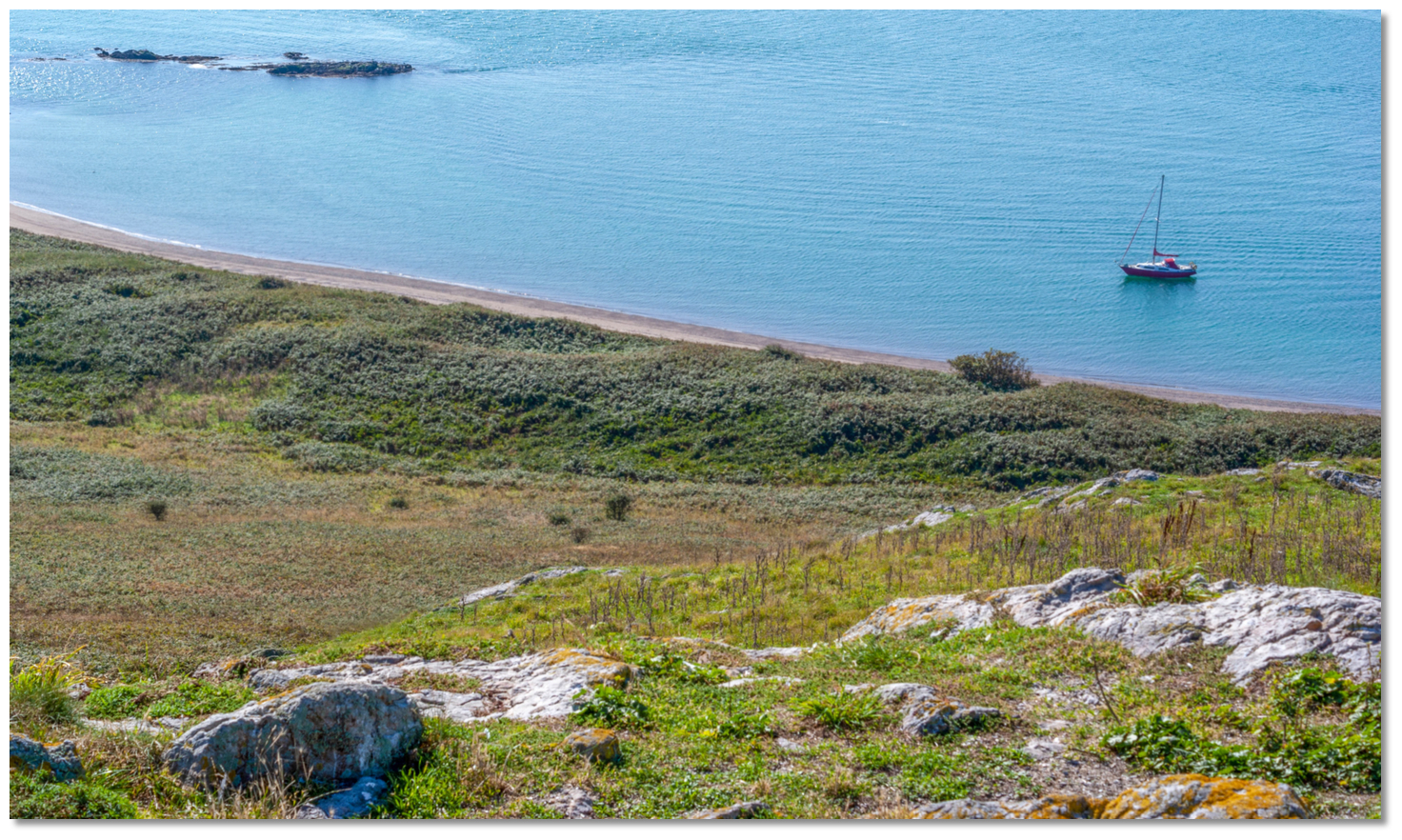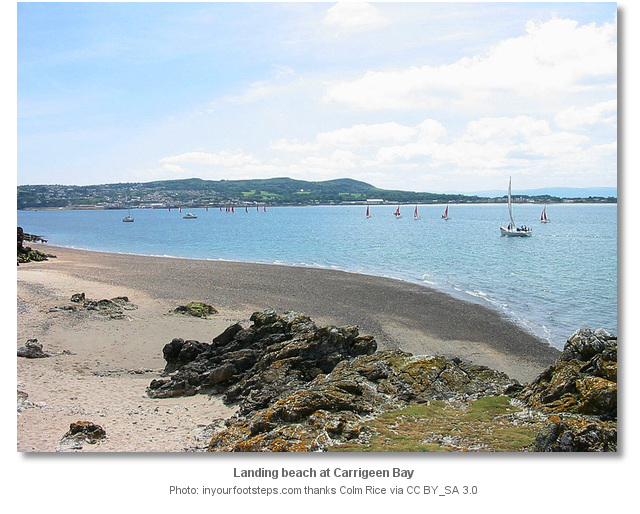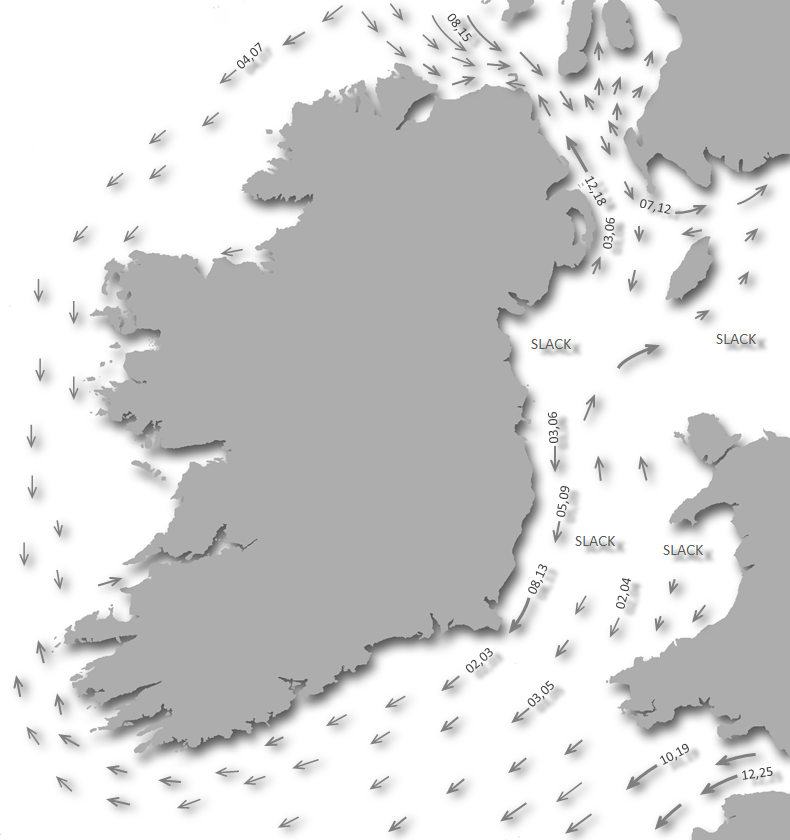
Ireland’s Eye is a small uninhabited island located off the north shore of the Howth peninsula immediately outside Howth Harbour on Ireland's east coast. Carrigeen Bay is situated on the west side of the island and offers a secluded anchorage.
Carrigeen Bay is a tolerable anchorage that is only serviceable in settled conditions and is used largely for a landing on Ireland’s Eye. It should be avoided in any unsettled weather and particularly after strong east or southeast conditions that cause a swell to run in Howth Sound. The anchorage may be approached from the seaward to the east and south between Howth Harbour and Irelands Eye, or from the north via Howth Sound. Access is straightforward in each case.

Keyfacts for Carrigeen Bay
Last modified
January 5th 2023 Summary
A tolerable location with straightforward access.Facilities
None listedNature




Considerations
Position and approaches
Expand to new tab or fullscreen
Haven position
 53° 24.270' N, 006° 4.320' W
53° 24.270' N, 006° 4.320' WThis is in the two metre contour off the landing beach where you can feel your way into a suitable depth.
What is the initial fix?
The following Howth Sound Initial Fix will set up a final approach:
 53° 24.500' N, 006° 4.665' W
53° 24.500' N, 006° 4.665' W What are the key points of the approach?
Offshore details are available in eastern Ireland’s Coastal Overview for Strangford Lough to Dublin Bay  . Use the directions provided for Howth
. Use the directions provided for Howth  for approaches to Carrigeen Bay. The Howth Sound initial fix sets up an approach into the anchorage or, alternately, use the Howth Fairway Initial Fix and round the south side of the island.
for approaches to Carrigeen Bay. The Howth Sound initial fix sets up an approach into the anchorage or, alternately, use the Howth Fairway Initial Fix and round the south side of the island.
 . Use the directions provided for Howth
. Use the directions provided for Howth  for approaches to Carrigeen Bay. The Howth Sound initial fix sets up an approach into the anchorage or, alternately, use the Howth Fairway Initial Fix and round the south side of the island.
for approaches to Carrigeen Bay. The Howth Sound initial fix sets up an approach into the anchorage or, alternately, use the Howth Fairway Initial Fix and round the south side of the island. Not what you need?
Click the 'Next' and 'Previous' buttons to progress through neighbouring havens in a coastal 'clockwise' or 'anti-clockwise' sequence. Below are the ten nearest havens to Carrigeen Bay for your convenience.
Ten nearest havens by straight line charted distance and bearing:
- Howth - 0.6 nautical miles SSE
- Balscadden Bay - 1.1 nautical miles SSE
- Malahide - 4.1 nautical miles NW
- Talbot’s Bay - 5.1 nautical miles NNE
- The Boat Harbour - 5.5 nautical miles NNE
- Seal Hole Bay - 5.6 nautical miles NNE
- Saltpan Bay - 5.8 nautical miles NNE
- Dublin Port - 6.4 nautical miles SW
- Rogerstown Inlet - 6.6 nautical miles NNW
- Dún Laoghaire Harbour - 6.7 nautical miles SSW
These havens are ordered by straight line charted distance and bearing, and can be reordered by compass direction or coastal sequence:
- Howth - 0.6 miles SSE
- Balscadden Bay - 1.1 miles SSE
- Malahide - 4.1 miles NW
- Talbot’s Bay - 5.1 miles NNE
- The Boat Harbour - 5.5 miles NNE
- Seal Hole Bay - 5.6 miles NNE
- Saltpan Bay - 5.8 miles NNE
- Dublin Port - 6.4 miles SW
- Rogerstown Inlet - 6.6 miles NNW
- Dún Laoghaire Harbour - 6.7 miles SSW
What's the story here?
 Cargreen Bay and Ireland's Eye
Cargreen Bay and Ireland's EyeImage: Michael Foley via CC BY-NC 2.0
Ireland’s Eye is an uninhabited barren island located about less than a mile to the north of Howth Harbour. The island encompasses Ireland’s Eye, Rowan Rocks, Thulla, Thulla Rocks, Carrageen Bay and a seaward extension of 200m in the west and 500m to the north and east. The main island has a registered area of 21.5 hectares (53 acres), plus a range of rocks and an islet called 'Thulla' to the south. It features some impressive near-vertical cliffs that reach 69 metres along the northern and eastern sides of the island and there are some scattered exposures elsewhere on the island. The site is a Special Protection Area (SPA) under the E.U. Birds Directive.
 Cargeen Bay beach
Cargeen Bay beach Image: Sonse via CC BY 2.0
Carrigeen Bay is located on the southwest side of Ireland’s Eye. It is a sandy beach, backed by low sandhills that offers an anchorage in settled conditions or offshore winds.
How to get in?
 Ireland's Eye as seen from the mainland over Howth Harbour
Ireland's Eye as seen from the mainland over Howth HarbourImage: Siobhan Pepper via CC BY-SA 2.0
 Use the directions provided for Howth
Use the directions provided for Howth  for approaches to Carrigeen Bay. From the Howth Sound Initial Fix the bearing on Howth Martello Tower track along the beach. The Howth Fairway Initial Fix may be used to round the south side of the island. The Martello tower and close-lying rock called The Steer, on the north-westernmost end of Ireland’s Eye, makes for an unmistakable seamark for the north end of the Bay.
for approaches to Carrigeen Bay. From the Howth Sound Initial Fix the bearing on Howth Martello Tower track along the beach. The Howth Fairway Initial Fix may be used to round the south side of the island. The Martello tower and close-lying rock called The Steer, on the north-westernmost end of Ireland’s Eye, makes for an unmistakable seamark for the north end of the Bay. The Steer off the island's north-westernmost end and the island's Martello
The Steer off the island's north-westernmost end and the island's MartelloImage: Michelle Claire Woolnough via CC BY 2.0
Vessels rounding the north end of the island should stand 200 metres off The Steer off the north-westernmost end of Ireland’s Eye, close north of the Martello tower. Although the island is steep-to there are a couple of off-lying dangers on this corner. A rock dries to a height of two metres approximately one hundred metres northeast of The Steer. There is also another sunken rock locally known as Mog Rock close west of The Steer. Uncharted and with 0.5 metres over it at CD it has caught many boats rounding too close to The Steer when entering or exiting Howth.
 Yacht anchored in Carrigeen Bay
Yacht anchored in Carrigeen BayImage: Nina via CC BY-SA 2.0
 Anchor in sand off the island according to draft and conditions. It is shoal out from the beach with the 2-metre contour being about 300 metres out from the island. Slightly deeper water can be found closer in at the north end of the beach. Daytrippers intending to explore the island may wish to take advantage of a rising tide to make the dinghy ride to the shore shorter by coming in closer.
Anchor in sand off the island according to draft and conditions. It is shoal out from the beach with the 2-metre contour being about 300 metres out from the island. Slightly deeper water can be found closer in at the north end of the beach. Daytrippers intending to explore the island may wish to take advantage of a rising tide to make the dinghy ride to the shore shorter by coming in closer. Why visit here?
Ireland's Eye, in Irish Inis Mac Neasáin, derives its name from a combination of Irish myth and ancient Norse. In Celtic times the small island was called 'Eria's Island'. 'Eria' being a woman's name that in time became confused with 'Erin', a derivation of Éireann that is the Irish name for Ireland. Later the Vikings substituted Ey, the Norse equivalent for Island, and so it acquired the name Erin's Ey that ultimately became Ireland's Eye. Church of the Three Sons of Nessan
Church of the Three Sons of NessanImage: Sonse via CC BY 2.0
But in the 7th-century the island bore the name of Inis mac Nessan meaning the 'island of the sons of Nessan'. 'Nessan' was a prince of the royal family of Leinster, who had seven sons, all distinguished for sanctity and miracles. It is believed that three sons of Nessan – Dichuill, Munissa and Neslug founded a monastery on the island during this period. Sadly little is known today of the early medieval ecclesiastical site on Ireland’s Eye and no trace of this exists today. The remnants seen today are of the later 8th-century church, the Church of the Three Sons of Nessan, more correctly called Kilmacnessan, that represents the only surviving physical remains of the island's ecclesiastical past. St Nessan’s became a parish church during the Anglo-Norman period, having formed the original prebendal lands and church of Archbishop Comyn’s Collegiate Chapter of St Patrick since 1190. This status was short-lived, however, as the prebend was transferred to St Mary’s of Howth in 1235, which then became a more conveniently located parish church.
 The Martello Tower with its high entrance
The Martello Tower with its high entranceImage: Asinka Photography via CC BY 2.0
The island's other man-made structure is the early 19th century Martello Tower situated on a rock outcrop at the northwest end of the island. It was part of a series of towers built around the coast of Ireland to defend against a Napoleonic invasion. Its corresponding compatriots overlook Howth Harbour and another at Red Rock, Sutton. Constructed in 1804 this is a 'Two-Gun Tower', that was armed with two 24- pounder guns, to command the anchorage and the approaches to Howth. The 'double-tower' has a basal plinth that is further defended by a machicolation making it the largest of the towers in north county Dublin. The entrance is a raised doorway on the south side, five metres above ground level with dressed limestone jambs. Much like the early medieval round towers, the raised doorway was designed to deter attackers with access only being gained by climbing the rope that hangs from the stone door-jamb.
 Ireland's Eye precipitous sea stacks and colonies from seaward
Ireland's Eye precipitous sea stacks and colonies from seawardImage: Michelle Claire Woolnough via CC BY 2.0
The island’s most spectacular natural feature is its substantial freestanding rock 'The Stack', situated on its northeastern corner opposite side to Carrigeen Bay. 'The Stack' plays host to a large variety of seabirds, including thousands of guillemots, razorbills, fulmars and gulls. This has led to the island being made a site is a Special Protection Area (SPA) under the E.U. Birds Directive. Of special conservation interest for the following species: Cormorant, Herring Gull, Kittiwake, Guillemot and Razorbill. Ireland's fifth gannet colony became established on 'The Stack' in the 1980s, and there are now a few hundred pairs which breed there each year. It is today one of six in the country and one of only two sites on the east coast. The colony has only been established as recently as the late 1980s and, as all breeding ledges became fully occupied in 2006, a satellite colony was then established on the nearby island of Lambay. A large cormorant colony and a few breeding pairs of puffins are also on the main island. Grey Seals are prolific in the sea around the island.
 The Martello's commanding view northward
The Martello's commanding view northwardImage: Tourism Ireland
Unlike its near neighbour Lambay Island, access to Ireland's Eye has never been restricted and admission is free. It is today one of the best places around Dublin for bird watching and has an abundance of spectacular scenery. This will be readily apparent upon landing as the island will be seen to gradual ascend from Carrigeen Bay. From the beach the low wall of the ruined church seen in the foreground with its hill clothed with heather, fern, and wild plants beyond. Higher up, and covered in lichen of a variety of colours, rise the rocky cliffs, on the north side. Once scaled they will be seen to descend precipitously to the sea, with interesting detached rocks and several caves into which the sea dashes that may only be seen only from seaward in calm weather. The Martello Tower and St. Nessan’s Church can be inspected at close quarters. Those planning to explore the island and particularly the church ruins should come prepared with long trousers as it is surrounded by a thicket of nettles. Please exercise care not to distress bird life during your visit and if you plan to rock climb please do so in late summer.
 A circumnavigation of the island is highly rewarding
A circumnavigation of the island is highly rewardingImage: William Murphy via CC BY SA 2.0
From a boating perspective, Carrigeen Bay offers attractive temporary anchorage to explore the island and its long sandy beach is an ideal destination for family boats. In offshore winds or very settled conditions, it may be possible to spend the night especially those who have the benefit of shallow-draft vessels which may come in close to make the best of its shelter.
What facilities are available?
There are no facilities or water available on Ireland’s Eye.Any security concerns?
Never an issue known to have occurred off Ireland’s Eye. You are most likely to be alone when anchored here.With thanks to:
Charlie Kavanagh, ISA/RYA Yachtmaster Instructor/Examiner.



An aerial view of the island commencing from Carrigeen Bay
The Carrigeen Bay approach from Howth Harbour
The approach into the Carrigeen Bay landing area
The view from the island of Carrigeen Bay
The view northward from the island's summit
The view of Howth Sound from the island's summit
About Carrigeen Bay
Ireland's Eye, in Irish Inis Mac Neasáin, derives its name from a combination of Irish myth and ancient Norse. In Celtic times the small island was called 'Eria's Island'. 'Eria' being a woman's name that in time became confused with 'Erin', a derivation of Éireann that is the Irish name for Ireland. Later the Vikings substituted Ey, the Norse equivalent for Island, and so it acquired the name Erin's Ey that ultimately became Ireland's Eye.
 Church of the Three Sons of Nessan
Church of the Three Sons of NessanImage: Sonse via CC BY 2.0
But in the 7th-century the island bore the name of Inis mac Nessan meaning the 'island of the sons of Nessan'. 'Nessan' was a prince of the royal family of Leinster, who had seven sons, all distinguished for sanctity and miracles. It is believed that three sons of Nessan – Dichuill, Munissa and Neslug founded a monastery on the island during this period. Sadly little is known today of the early medieval ecclesiastical site on Ireland’s Eye and no trace of this exists today. The remnants seen today are of the later 8th-century church, the Church of the Three Sons of Nessan, more correctly called Kilmacnessan, that represents the only surviving physical remains of the island's ecclesiastical past. St Nessan’s became a parish church during the Anglo-Norman period, having formed the original prebendal lands and church of Archbishop Comyn’s Collegiate Chapter of St Patrick since 1190. This status was short-lived, however, as the prebend was transferred to St Mary’s of Howth in 1235, which then became a more conveniently located parish church.
 The Martello Tower with its high entrance
The Martello Tower with its high entranceImage: Asinka Photography via CC BY 2.0
The island's other man-made structure is the early 19th century Martello Tower situated on a rock outcrop at the northwest end of the island. It was part of a series of towers built around the coast of Ireland to defend against a Napoleonic invasion. Its corresponding compatriots overlook Howth Harbour and another at Red Rock, Sutton. Constructed in 1804 this is a 'Two-Gun Tower', that was armed with two 24- pounder guns, to command the anchorage and the approaches to Howth. The 'double-tower' has a basal plinth that is further defended by a machicolation making it the largest of the towers in north county Dublin. The entrance is a raised doorway on the south side, five metres above ground level with dressed limestone jambs. Much like the early medieval round towers, the raised doorway was designed to deter attackers with access only being gained by climbing the rope that hangs from the stone door-jamb.
 Ireland's Eye precipitous sea stacks and colonies from seaward
Ireland's Eye precipitous sea stacks and colonies from seawardImage: Michelle Claire Woolnough via CC BY 2.0
The island’s most spectacular natural feature is its substantial freestanding rock 'The Stack', situated on its northeastern corner opposite side to Carrigeen Bay. 'The Stack' plays host to a large variety of seabirds, including thousands of guillemots, razorbills, fulmars and gulls. This has led to the island being made a site is a Special Protection Area (SPA) under the E.U. Birds Directive. Of special conservation interest for the following species: Cormorant, Herring Gull, Kittiwake, Guillemot and Razorbill. Ireland's fifth gannet colony became established on 'The Stack' in the 1980s, and there are now a few hundred pairs which breed there each year. It is today one of six in the country and one of only two sites on the east coast. The colony has only been established as recently as the late 1980s and, as all breeding ledges became fully occupied in 2006, a satellite colony was then established on the nearby island of Lambay. A large cormorant colony and a few breeding pairs of puffins are also on the main island. Grey Seals are prolific in the sea around the island.
 The Martello's commanding view northward
The Martello's commanding view northwardImage: Tourism Ireland
Unlike its near neighbour Lambay Island, access to Ireland's Eye has never been restricted and admission is free. It is today one of the best places around Dublin for bird watching and has an abundance of spectacular scenery. This will be readily apparent upon landing as the island will be seen to gradual ascend from Carrigeen Bay. From the beach the low wall of the ruined church seen in the foreground with its hill clothed with heather, fern, and wild plants beyond. Higher up, and covered in lichen of a variety of colours, rise the rocky cliffs, on the north side. Once scaled they will be seen to descend precipitously to the sea, with interesting detached rocks and several caves into which the sea dashes that may only be seen only from seaward in calm weather. The Martello Tower and St. Nessan’s Church can be inspected at close quarters. Those planning to explore the island and particularly the church ruins should come prepared with long trousers as it is surrounded by a thicket of nettles. Please exercise care not to distress bird life during your visit and if you plan to rock climb please do so in late summer.
 A circumnavigation of the island is highly rewarding
A circumnavigation of the island is highly rewardingImage: William Murphy via CC BY SA 2.0
From a boating perspective, Carrigeen Bay offers attractive temporary anchorage to explore the island and its long sandy beach is an ideal destination for family boats. In offshore winds or very settled conditions, it may be possible to spend the night especially those who have the benefit of shallow-draft vessels which may come in close to make the best of its shelter.
Other options in this area
Click the 'Next' and 'Previous' buttons to progress through neighbouring havens in a coastal 'clockwise' or 'anti-clockwise' sequence. Alternatively here are the ten nearest havens available in picture view:
Coastal clockwise:
Howth - 0.4 miles SSEBalscadden Bay - 0.7 miles SSE
Dublin Port - 3.9 miles SW
Dún Laoghaire Harbour - 4.2 miles SSW
Dalkey Island - 4.9 miles S
Coastal anti-clockwise:
Malahide - 2.5 miles NWTalbot’s Bay - 3.2 miles NNE
Seal Hole Bay - 3.5 miles NNE
Saltpan Bay - 3.6 miles NNE
The Boat Harbour - 3.4 miles NNE
Navigational pictures
These additional images feature in the 'How to get in' section of our detailed view for Carrigeen Bay.










| Detail view | Off |
| Picture view | On |
An aerial view of the island commencing from Carrigeen Bay
The Carrigeen Bay approach from Howth Harbour
The approach into the Carrigeen Bay landing area
The view from the island of Carrigeen Bay
The view northward from the island's summit
The view of Howth Sound from the island's summit
Add your review or comment:
Please log in to leave a review of this haven.
Please note eOceanic makes no guarantee of the validity of this information, we have not visited this haven and do not have first-hand experience to qualify the data. Although the contributors are vetted by peer review as practised authorities, they are in no way, whatsoever, responsible for the accuracy of their contributions. It is essential that you thoroughly check the accuracy and suitability for your vessel of any waypoints offered in any context plus the precision of your GPS. Any data provided on this page is entirely used at your own risk and you must read our legal page if you view data on this site. Free to use sea charts courtesy of Navionics.














